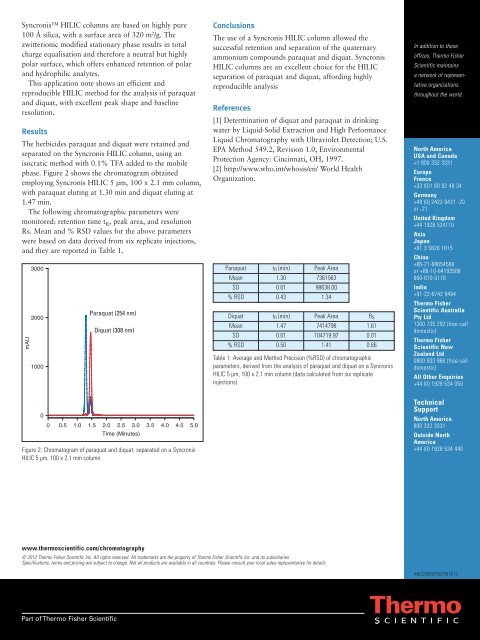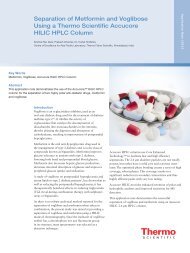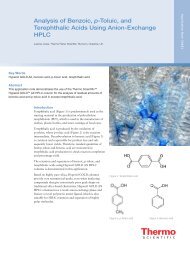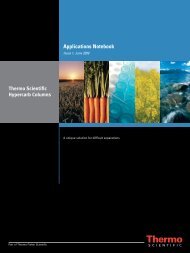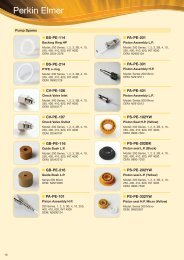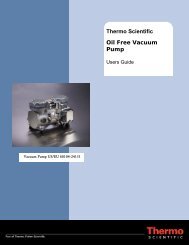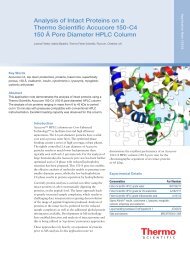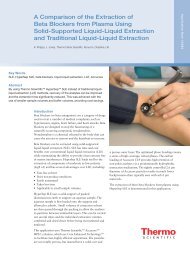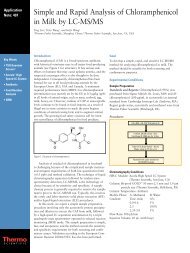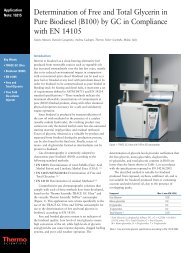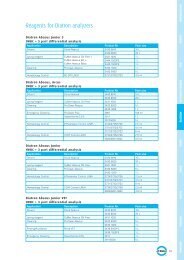HILIC Method for the Separation of Diquat and Paraquat
HILIC Method for the Separation of Diquat and Paraquat
HILIC Method for the Separation of Diquat and Paraquat
You also want an ePaper? Increase the reach of your titles
YUMPU automatically turns print PDFs into web optimized ePapers that Google loves.
Syncronis <strong>HILIC</strong> columns are based on highly pure<br />
100 Å silica, with a surface area <strong>of</strong> 320 m 2 /g. The<br />
zwitterionic modified stationary phase results in total<br />
charge equalisation <strong>and</strong> <strong>the</strong>re<strong>for</strong>e a neutral but highly<br />
polar surface, which <strong>of</strong>fers enhanced retention <strong>of</strong> polar<br />
<strong>and</strong> hydrophilic analytes.<br />
This application note shows an efficient <strong>and</strong><br />
reproducible <strong>HILIC</strong> method <strong>for</strong> <strong>the</strong> analysis <strong>of</strong> paraquat<br />
<strong>and</strong> diquat, with excellent peak shape <strong>and</strong> baseline<br />
resolution.<br />
Results<br />
The herbicides paraquat <strong>and</strong> diquat were retained <strong>and</strong><br />
separated on <strong>the</strong> Syncronis <strong>HILIC</strong> column, using an<br />
isocratic method with 0.1% TFA added to <strong>the</strong> mobile<br />
phase. Figure 2 shows <strong>the</strong> chromatogram obtained<br />
employing Syncronis <strong>HILIC</strong> 5 µm, 100 x 2.1 mm column,<br />
with paraquat eluting at 1.30 min <strong>and</strong> diquat eluting at<br />
1.47 min.<br />
The following chromatographic parameters were<br />
monitored: retention time t R , peak area, <strong>and</strong> resolution<br />
Rs. Mean <strong>and</strong> % RSD values <strong>for</strong> <strong>the</strong> above parameters<br />
were based on data derived from six replicate injections,<br />
<strong>and</strong> <strong>the</strong>y are reported in Table 1.<br />
mAU<br />
3000<br />
2000<br />
1000<br />
<strong>Paraquat</strong> (254 nm)<br />
<strong>Diquat</strong> (308 nm)<br />
Conclusions<br />
The use <strong>of</strong> a Syncronis <strong>HILIC</strong> column allowed <strong>the</strong><br />
successful retention <strong>and</strong> separation <strong>of</strong> <strong>the</strong> quaternary<br />
ammonium compounds paraquat <strong>and</strong> diquat. Syncronis<br />
<strong>HILIC</strong> columns are an excellent choice <strong>for</strong> <strong>the</strong> <strong>HILIC</strong><br />
separation <strong>of</strong> paraquat <strong>and</strong> diquat, af<strong>for</strong>ding highly<br />
reproducible analysis<br />
References<br />
[1] Determination <strong>of</strong> diquat <strong>and</strong> paraquat in drinking<br />
water by Liquid-Solid Extraction <strong>and</strong> High Per<strong>for</strong>mance<br />
Liquid Chromatography with Ultraviolet Detection; U.S.<br />
EPA <strong>Method</strong> 549.2, Revision 1.0, Environmental<br />
Protection Agency: Cincinnati, OH, 1997.<br />
[2] http://www.who.int/whosis/en/ World Health<br />
Organization.<br />
<strong>Paraquat</strong> t R (min) Peak Area<br />
Mean 1.30 7361563<br />
SD 0.01 98638.00<br />
% RSD 0.43 1.34<br />
<strong>Diquat</strong> t R (min) Peak Area Rs<br />
Mean 1.47 7414798 1.61<br />
SD 0.01 104719.97 0.01<br />
% RSD 0.50 1.41 0.66<br />
Table 1: Average <strong>and</strong> <strong>Method</strong> Precision (%RSD) <strong>of</strong> chromatographic<br />
parameters, derived from <strong>the</strong> analysis <strong>of</strong> paraquat <strong>and</strong> diquat on a Syncronis<br />
<strong>HILIC</strong> 5 µm, 100 x 2.1 mm column (data calculated from six replicate<br />
injections)<br />
In addition to <strong>the</strong>se<br />
<strong>of</strong>fices, Thermo Fisher<br />
Scientific maintains<br />
a network <strong>of</strong> represen -<br />
tative organizations<br />
throughout <strong>the</strong> world.<br />
North America<br />
USA <strong>and</strong> Canada<br />
+1 800 332 3331<br />
Europe<br />
France<br />
+33 (0)1 60 92 48 34<br />
Germany<br />
+49 (0) 2423 9431 -20<br />
or -21<br />
United Kingdom<br />
+44 1928 534110<br />
Asia<br />
Japan<br />
+81 3 5826 1615<br />
China<br />
+86-21-68654588<br />
or +86-10-84193588<br />
800-810-5118<br />
India<br />
+91-22-6742 9494<br />
Thermo Fisher<br />
Scientific Australia<br />
Pty Ltd<br />
1300 735 292 (free call<br />
domestic)<br />
Thermo Fisher<br />
Scientific New<br />
Zeal<strong>and</strong> Ltd<br />
0800 933 966 (free call<br />
domestic)<br />
All O<strong>the</strong>r Enquiries<br />
+44 (0) 1928 534 050<br />
0<br />
0 0.5 1.0 1.5 2.0 2.5 3.0 3.5 4.0 4.5 5.0<br />
Time (Minutes)<br />
Figure 2: Chromatogram <strong>of</strong> paraquat <strong>and</strong> diquat, separated on a Syncronis<br />
<strong>HILIC</strong> 5 µm, 100 x 2.1 mm column<br />
Technical<br />
Support<br />
North America<br />
800 332 3331<br />
Outside North<br />
America<br />
+44 (0) 1928 534 440<br />
www.<strong>the</strong>rmoscientific.com/chromatography<br />
© 2012 Thermo Fisher Scientific Inc. All rights reserved. All trademarks are <strong>the</strong> property <strong>of</strong> Thermo Fisher Scientific Inc. <strong>and</strong> its subsidiaries.<br />
Specifications, terms <strong>and</strong> pricing are subject to change. Not all products are available in all countries. Please consult your local sales representative <strong>for</strong> details.<br />
ANCCSDIQPAQSYN 0112<br />
Part <strong>of</strong> Thermo Fisher Scientific


